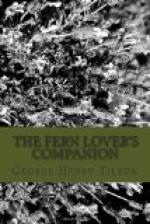HERBARIUM OF JOHN DOE Ophioglossum vulgatum, L. (Adder’s Tongue) Willoughby Lake, Vt. August 19, 1911. Wet meadow. Coll. X.Y.Z. Rather common but often overlooked
Place the label at the lower right-hand corner of the sheet, which is now ready to be laid in the genus cover, usually of manila paper 16-1/2 by 12 inches.
It is well to jot down important memoranda at the time of collecting. This is the method in use at the Gray Herbarium in Cambridge. It can, of course, be modified to suit one’s own taste or convenience. The young collector can begin by simply pressing his specimens between the leaves of a book, the older and coarser the better; and he can mount them in a blank book designed for the purpose, or if he has only a common blank book, he can cut out some of the leaves, alternately with others left in place, as is often done with a scrap book, that when the book is full it may not be crowded at the back. Or he can use sheets of blank paper of any uniform size and mount the specimens on these with gummed strips, and then group them, placing those of the same genus together. Such an extemporized herbarium, though crude, will serve for a beginning, while stimulating his interest, and advancing his knowledge of the ferns. Let him collect, press, and mount as many varieties as possible, giving the name with date and place of collecting, etc. Such a first attempt may be kept as a reminder of pleasant hours spent in learning the rudiments of a delightful study.
We cannot insist too strongly upon the necessity of handling and studying the living plant. Every student needs to observe for himself the haunts, habits, and structure of real ferns. We would say to the young student, while familiarizing yourself with the English names of the ferns, do not neglect the scientific names, which often hold the key to their meaning. Repeat over and over the name of each genus in soliloquy and in conversation until your mind instantly associates each fern with its family name—“Adiantum,” “Polystichum,” “Asplenium,” and all the rest. Fix them in the memory for a permanent asset. With hard study and growing knowledge will come growing attachment. How our great expert, Mr. Davenport, loved the ferns! He would handle them with gentle touch, fondly stroke their leaves, and devoutly study their structure, as if inspired by the All-wise Interpreter.
“Move along these shades
In gentleness of heart: with gentle
hand
Touch—for there is a spirit
in the woods.”
KEY TO THE GENERA
This key, in illustrating each genus, follows the method of Clute in “Our Ferns in Their Haunts,” but substitutes other and larger specimens. Five of these are from Waters’ “Ferns” by permission of Henry Holt & Co.
As the indusium, which often determines the name of a fern, is apt in some species to wither early, it is important to secure for study not only a fertile frond, but one in as good condition as possible. For convenience the ferns may be considered in two classes.




